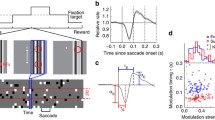Abstract
Involuntary eye movements were recorded during threshold detection tasks under various experimental conditions. The data were analyzed for interdependencies between stimulus parameters, detection performance, and oculomotor behaviour.
The data demonstrate that under certain conditions, saccadic parameters are adaptive to specific stimulus properties. Further, the data suggest that for stationary patterns with low spatial frequencies and for gratings flickering with high temporal frequencies, detection is facilitated considerably by the occurrence of a saccadic eye movement. These facilitation effects are consistent with the predictions of a theoretical model presented in a previous paper.
Similar content being viewed by others
References
Arend LE, Skavenski AA (1979) Free scanning of gratings produces patterned retinal exposure. Vision Res 19:1413–1419
Bridgeman B, Palca J (1980) The role of microsaccades in high acuity observational tasks. Vision Res 20:813–817
Bridgeman B, Hendry D, Stark L (1975) Failure to detect displacement of the visual world during saccadic eye movements. Vision Res 15:719–722
Ditchburn RW (1973) Eye movements and visual perception. Clarendon Press, Oxford
Ditchburn RW, Ginsborg BL (1952) Vision with a stabilized retinal image. Nature 170:36–37
Elsner T, Deubel H (1986) The effect of saccades on threshold perception — a model study. Biol Cybern 54:359–366
Hauske G, Deubel H (1984) Temporal responses to switched and saccade induced flicker modulation onset. Invest Ophthalmol Vis Sci 25:Suppl: 70
Kelly DH (1979a) Motion and vision. I. Stabilized images of stationary gratings. J Opt Soc Am 69:1266–1274
Kelly DH (1979b) Motion and vision. II. Stabilized spatiotemporal threshold surface. J. Opt Soc Am 69:1340–1349
Kelly DH (1979c) Pattern adaptation with artificial eye movements. Invest Ophthalmol Vis Sci 17, Suppl: 140
Kelly DH (1981) Disappearance of stabilized chromatic gratings. Science 214:1257–1258
Kelly DH, Burbeck CA (1980) Motion and vision. III. Stabilized pattern adaptation. J Opt Soc Am 70:1283–1289
King-Smith PE, Riggs LA (1978) Visual sensitivity to controlled motion of a line or edge. Vision Res 18:1509–1520
Koenderink JJ, van Doorn AJ (1979) Spatiotemporal contrast detection threshold surface is bimodal. Opt Lett 4:32–34
Kowler E, Sperling G (1980) Transient stimulation does not aid visual search: implications for the role of saccades. Percept Psychophys 27:1–10
Kowler E, Steinman RM (1977) The role of small saccades in counting. Vision Res 17:141–146
Kulikowski JJ (1971) Effect of eye movements on the contrast sensitivity of spatiotemporal patterns. Vision Res 11:261–273
Levinson JZ (1968) Flicker fusion phenomena. Science 160:21–28
Matin E (1974) Saccadic suppression: a review and an analysis. Psychol Bull 81:899–917
Riggs LA, Ratliff F, Cornsweet JC, Cornsweet TN (1953) The disappearance of steadily fixated visual test objects. J Opt Soc Am 54:495–501
Steinman RM, Haddad GM, Skavenski AA, Wyman D (1973) Miniature eye movements. Science 181:811–819
Tulunay-Keesey U, Baker ED (1982) Eye movements: stabilized and normal viewing. Invest Ophthalmol Vis Sci 22, Suppl: 49
Tulunay-Keesey U, Jones RM (1976) The effect of micromovements of the eye and exposure duration on contrast sensitivity. Vision Res 16:481–488
Tulunay-Keesey U, Bennis B (1979) Effects of stimulus onsets and image motion on contrast sensitivity. Vision Res 19:767–774
Weymouth F, Andersen E, Averill H (1923) Retinal mean local sign: a new view of the relation of the retinal mosaic to visual perception. Am J Physiol 63:410
Wolf W, Deubel H, Hauske G (1984) Interaction between saccadic and manual reactions. Invest Ophthalmol Vis Sci 25, Suppl: 262
Yarbus AL (1967) Eye movements and vision. In: Riggs LA (ed) Plenum Press, New York
Author information
Authors and Affiliations
Rights and permissions
About this article
Cite this article
Deubel, H., Elsner, T. Threshold perception and saccadic eye movements. Biol. Cybern. 54, 351–358 (1986). https://doi.org/10.1007/BF00355540
Received:
Issue Date:
DOI: https://doi.org/10.1007/BF00355540




